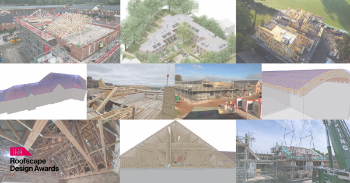Garden
A garden is an enclosed area of, typically external, land that is cultivated with natural and ornamental features.
The most common type of garden is a residential garden, which a domestic building. However, there are many different variations, including:
- Winter garden: A garden maintained throughout winter.
- Landscape garden: A large-scale landscape.
- Zen garden: A small-scale idealised landscape with plants usually kept to a minimum.
- French formal garden: Based on symmetry and the idea of imposing order on nature.
- Tropical garden: Tropical conditions are created to enable the cultivation of tropical plants.
- Roof garden: A garden located on the roof of a building.
- Kitchen garden: and ornamental vegetable garden.
- English garden: A style of landscape garden that idealises nature.
While residential gardens are often maintained by the property owner, professional gardeners, horticulturists and landscape architects are often involved in the design of larger-scale or specialist gardens.
Garden design involves drawing up plans for laying out and planting different landscapes, and this will largely be determined by the purpose for which the garden is intended. Some gardens are purely for aesthetic or ornamental purposes, while others can be more functional – growing food and other crops, and so on.
Other considerations for the planting of gardens include:
- The location, climate and exposure.
- The soil type.
- Topography.
- Means of access.
- The potential for pests to damage the garden.
- The horticultural requirements.
- The appearance of the plants season-by-season.
- The typical lifespan of the plants.
- The growth habits of the plants – their size, rate of growth, and so on.
- The maintenance needs of the garden.
- The elements of hard landscape and other features that will be included.
- How the garden will be used.
- How the garden will connect and/or interact with the building or other structures.
- Privacy and security.
- Budget and time constraints.
The natural elements included in a garden typically comprise:
- Flora (trees, shrubs, lawns, etc.).
- Fauna (anthropods, birds, etc.).
- Soil, compost, mulch, etc.
- Water (streams, ponds, etc.).
For more information, see soft landscape.
Some of the hard landscape (or hardscape) elements that can be part of a garden include:
- Paths.
- Patios.
- Decking.
- Sculptures.
- Fencing and walls.
- Drainage systems.
- Irrigation systems (e.g. sprinklers).
- Lights.
- Structures (e.g. sheds, gazebos, pergolas, follies, greenhouses).
- Water features (e.g. fountains, ponds, creeks, waterfalls).
- Trellises.
NB A Guide To Climate Change Impacts, On Scotland’s Historic Environment, published by Historic Environment Scotland in October 2019, defines gardens and designed landscapes as: ‘A category of asset encompassing botanic gardens, parks, landscapes laid out for artistic effect and a range of features within these areas.’
For more information, see hard landscape.
[edit] Related articles on Designing Buildings Wiki
- Allotment.
- Clairvoyee.
- Crinkle crankle wall.
- Exedra.
- Eyecatcher.
- Fire pit.
- Folly.
- Fountain.
- Garden cities.
- Garden land.
- Gazebo.
- Green roof.
- Growing space.
- Hard landscape.
- Hardy Plants and Plantings for Repton and Late Georgian Gardens (1780-1820).
- Hydroponics.
- Landscape architect.
- Landscape design.
- Lawn.
- Low maintenance plants.
- Park.
- Parterre.
- Pavilion.
- Planting.
- Rain garden.
- Rainwater harvesting.
- Seeding and turfing.
- Sharawadgi.
- Soft landscape.
- Summerhouse.
- The secret life of the Georgian garden.
- Topiary.
- Types of garden fountain.
- Walled kitchen gardens of the Isle of Wight.
Featured articles and news
Moisture, fire safety and emerging trends in living walls
How wet is your wall?
Current policy explained and newly published consultation by the UK and Welsh Governments.
British architecture 1919–39. Book review.
Conservation of listed prefabs in Moseley.
Energy industry calls for urgent reform.
Heritage staff wellbeing at work survey.
A five minute introduction.
50th Golden anniversary ECA Edmundson apprentice award
Showcasing the very best electrotechnical and engineering services for half a century.
Welsh government consults on HRBs and reg changes
Seeking feedback on a new regulatory regime and a broad range of issues.
CIOB Client Guide (2nd edition) March 2025
Free download covering statutory dutyholder roles under the Building Safety Act and much more.
AI and automation in 3D modelling and spatial design
Can almost half of design development tasks be automated?
Minister quizzed, as responsibility transfers to MHCLG and BSR publishes new building control guidance.
UK environmental regulations reform 2025
Amid wider new approaches to ensure regulators and regulation support growth.
The maintenance challenge of tenements.
BSRIA Statutory Compliance Inspection Checklist
BG80/2025 now significantly updated to include requirements related to important changes in legislation.
Shortlist for the 2025 Roofscape Design Awards
Talent and innovation showcase announcement from the trussed rafter industry.























